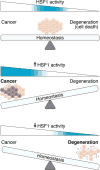The stress response paradox: fighting degeneration at the cost of cancer
- PMID: 27225066
- PMCID: PMC5672919
- DOI: 10.1111/febs.13764
The stress response paradox: fighting degeneration at the cost of cancer
Abstract
In the modern research era, sequencing and high-throughput analysis have linked genetic factors with a multitude of disease states. Often times, the same cellular machinery is implicated in several different diseases and has made it challenging to drug a particular disease with minimal pleotropic consequences. It is intriguing to see how different fields of disease research can present such differing views when describing the same biological process, pathway, or molecule. As observations in one field converge with research in another, we gain a more complete picture of a biological system and can accurately assess the feasibility for translational science. As an example discussed here, modulating latent stress response pathways within the cell provides exciting therapeutic potential, however, opposing views have emerged in the fields of degenerative disease and cancer. This at first glance seems logical as suppression of degenerative disease entails maintaining cell viability, while cancer aims to enhance selective senescence and cell death. As both of these disciplines seek novel therapeutic interventions, we should not overlook how scientific biases involving one biological process may impact different disease paradigms.
Keywords: Caenorhabditis elegans; aging; cancer; degeneration; heat shock factor; heat shock response; neurodegeneration; proteotoxic stress; stress.
© 2016 Federation of European Biochemical Societies.
Figures


Similar articles
-
Proteotoxic stress of cancer: implication of the heat-shock response in oncogenesis.J Cell Physiol. 2012 Aug;227(8):2982-7. doi: 10.1002/jcp.24017. J Cell Physiol. 2012. PMID: 22105155 Free PMC article. Review.
-
HSFA2 orchestrates transcriptional dynamics after heat stress in Arabidopsis thaliana.Transcription. 2016 Aug 7;7(4):111-4. doi: 10.1080/21541264.2016.1187550. Epub 2016 Jul 6. Transcription. 2016. PMID: 27383578 Free PMC article. Review.
-
Heat shock transcription factor 1 as a therapeutic target in neurodegenerative diseases.Nat Rev Drug Discov. 2011 Dec 1;10(12):930-44. doi: 10.1038/nrd3453. Nat Rev Drug Discov. 2011. PMID: 22129991 Free PMC article. Review.
-
Analysis of the mammalian heat-shock response. Inducible gene expression and heat-shock factor activity.Methods Mol Biol. 2000;99:217-55. doi: 10.1385/1-59259-054-3:217. Methods Mol Biol. 2000. PMID: 10909088 Review. No abstract available.
-
[Regulation of heat shock gene expression in response to stress].Mol Biol (Mosk). 2017 May-Jun;51(3):400-417. doi: 10.7868/S0026898417020100. Mol Biol (Mosk). 2017. PMID: 28707656 Review. Russian.
Cited by
-
Trauma-induced regulation of VHP-1 modulates the cellular response to mechanical stress.Nat Commun. 2021 Mar 5;12(1):1484. doi: 10.1038/s41467-021-21611-8. Nat Commun. 2021. PMID: 33674585 Free PMC article.
-
Small Heat Shock Proteins in Cancers: Functions and Therapeutic Potential for Cancer Therapy.Int J Mol Sci. 2020 Sep 10;21(18):6611. doi: 10.3390/ijms21186611. Int J Mol Sci. 2020. PMID: 32927696 Free PMC article. Review.
-
Proteotoxic Stress Desensitizes TGF-beta Signaling Through Receptor Downregulation in Retinal Pigment Epithelial Cells.Curr Mol Med. 2017;17(3):189-199. doi: 10.2174/1566524017666170619113435. Curr Mol Med. 2017. PMID: 28625142 Free PMC article.
References
-
- Kaiser J. Hormesis. Sipping from a poisoned chalice. Science. 2003;302:376–379. - PubMed
-
- Gems D, Partridge L. Stress-response hormesis and aging:"that which does not kill us makes us stronger”. Cell Metab. 2008;7:200–203. - PubMed
-
- Ritossa FM, Vonborstel RC. Chromosome puffs in Drosophila induced by ribonuclease. Science. 1964;145:513–514. - PubMed
-
- Lindquist S, Craig EA. The heat-shock proteins. Annu Rev Genet. 1988;22:631–677. - PubMed
-
- Haynes CM, Ron D. The mitochondrial UPR – protecting organelle protein homeostasis. J Cell Sci. 2010;123:3849–3855. - PubMed
Publication types
MeSH terms
Substances
Grants and funding
LinkOut - more resources
Full Text Sources
Other Literature Sources
Research Materials

